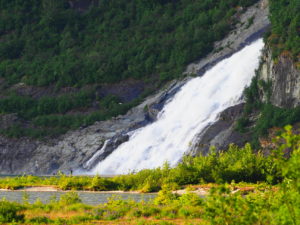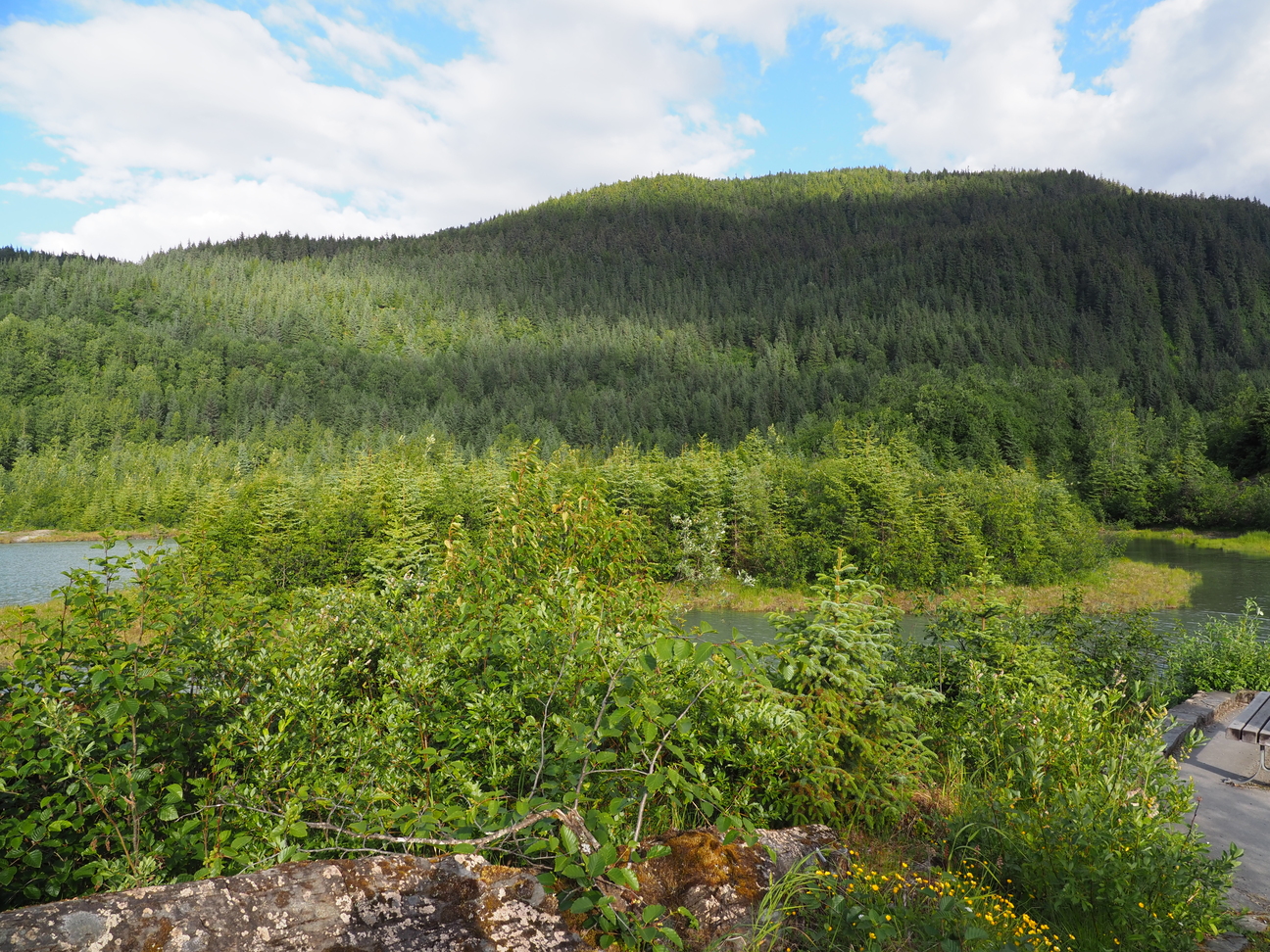The world’s remaining and endangered temperate rainforests, found mostly in Alaska, British Columbia and the Pacific Northwest, received major protection this week thanks to actions by the Biden administration and the provincial government of British Columbia, Canada’s third largest province.
The U.S. Department of Agriculture officially reinstated the Clinton-era National Roadless Rule in Southeast Alaska’s vast seventeen million-acre Tongass National Forest. The rule precludes additional building of logging roads to access the tallest, oldest and most sought-after trees including cedars up to 1,000 years old.
On the other side of the border, British Columbia’s Premier David Eby announced protection of 75,000 hectares of the Incomappleux Valley, located near Revelstoke in the Selkirk Range and site of an interior rain forest inhabited by grizzly bears, rare woodland caribou and known for its bull trout. A hectare equals 2.471 acres.
The valley is one of B.C.’s “greatest treasures,” said Eby, adding: “It’s home to old growth cedars and hemlock trees that are four meters in diameter. Over two hundred and fifty species of lichen can be found in these forests, including several that are completely new to science.”
Senator Maria Cantwell, D‑Washington, captained resistance to the Trump Administration when it removed the Tongass from Roadless Rule protection and began to identify valley-bottom forests for clearcutting.
Cantwell, a conservation champion, noted that the free flowing streams of America’s largest national forest are responsible for seventy-five percent of Southeast Alaska’s commercial salmon catch, or forty million fish in 2020.
“This is phenomenal news for one of the world’s last great remaining temperate forests,” said Cantwell. “The Tongass’ pristine forest lands are an enduring gift to the Pacific Northwest that supports thousands of regional tourism and fishing jobs. The salmon runs, recreational appeal and irreplaceable carbon storage the Tongass currently provides will always be more valuable to our communities than any subsidized logging projects.”
The term “rainforest” is often associated with the threatened Amazon Basin in South America, often called the “lungs of the planet” for its carbon storage.
Our part of the world, however, features temperate rainforests located along the West Coast and in interior ranges where moisture meets mountain ranges.
Logging has cut into these forests. Parts of the Tongass, notably Prince of Wales and Chichagof Islands, were once heavily cut to supply huge pulp mills at Ketchikan and Sitka. The 1980 Alaska Lands Act protected six million acres of the Tongass as wilderness, but much of the protected land consisted of glaciers, rocky peaks and coastlines, and muskeg bogs.
Reinstatement of the Roadless Rule is “key to conserving biodiversity and addressing the climate crisis,” said U.S. Agriculture Secretary Tom Vilsack. It covers 9.4 million acres, more than half of the Tongass. All told, the Roadless Rule applies to 58.5 million acres of the country’s 161 million acre national forest system. In this state, it has forestalled logging of such places as Quinault Ridge on the Olympic Peninsula and the Kettle Range in northeast Washington.
Gloria Burns, vice president of the Ketchikan Indian Community, welcomes restored protection in the Tongass. “I come from a family of weavers and we rely culturally, spiritually and economically on a thriving, and healthy old growth forest,” said she. “We will be in this place until the end of time and our cultures depend on and revolve around our natural world.”

But Senator Lisa Murkowski, R‑Alaska, described reinstatement of the Roadless Rule as “federal paternalism at its worst”, with land use turning into a “political football” changing hands with whatever political party occupies the White House.
“It is a beautiful place and we don’t want it becoming paved necessarily but I also think that it’s important for Alaskans to have access to the resources that they need,” said Representative Mary Peltola, D‑Alaska.
The timber industry has sharply declined in Southeast Alaska. Both of the big pulp mills shut down years ago. Tourism and recreation, from cruise ship visits to fishing lodges, have, however, boomed.
In British Columbia, the great forests of the Incomappleux Valley are hundreds of miles from the Pacific Coast. They are a product of climate. The jet stream sends storms east to where they run into peas of the Selkirks, Purcells, Caribou and Rocky Mountains. The headwaters of the U‑shaped, glacier-sculpted river valley are in Canada’s Glacier National Park and 11,000-foot summits and icefields.
“I hiked up the Incomappleux this summer to go fly fishing for bull trout,” said Keenan Simpson, a champion Canadian kayaker who once went to Garfield High School. “Some call it Bull River but I didn’t get a bite. It’s beautiful and green in there. Very glad it’s protected. I will return in the spring when it floods to attempt a kayak descent.”
Remaining rainforest old growth in the interior is “incredibly rare,” said B.C. Environment Minister George Heyman.
The province has turned much of its old growth into tree farm licenses, giving logging companies carte blanche to cut. “We thought we could go in and harvest without paying attention to the impacts: We all now know, including corporations, that we can’t do that,” Heyman told a news conference in Victoria.
Interfor, one of the world’s largest timber companies, “released” the Incomappleux from its tree farm license so the province could protect it.
There was a ransom involved. The Nature Conservancy midwifed collection of $4 million (Canadian) to compensate Interfor.
The Seattle-based Wilberforce Foundation was a contributor.
The province is creating a 58,000 hectares conservancy, covering about three-quarters of the valley, in which logging, mining and large-scale hydro development will be forbidden. Another 17,000 hectares in the lower valley will see no logging but mineral exploration will be allowed.
Premier Eby reflected on how opinion in his province has changed.
Sixty years ago, a colorful British Columbia cabinet minister and preacher named Phil Gaglardi proclaimed, “God didn’t put those trees there for man to worship. He put them there to be cut down.” One vast clearcut, in the Bowron River, showed up in pictures from space.
“They believed we had to choose between growing the economy and protecting unique wild spaces lie this for generations to come,” said Eby. “That’s a false choice. British Columbians now we can do both.”
The premier’s words will be tested. Local and provincial conservationists are fighting to keep loggers out of Argonaut Creek, north of Revelstoke, and the Rausch River to the north in the Caribou River. Both are sites of cathedral forests below towering peaks of interior British Columbia.
Speaking in Victoria, celebrating protection of the Incomappleux, was Chief James Tomma of the Skw’laxte Secwepema Lecu (or Little Shuswap) native band.
“Old growth are just seen as a dollar value,” he said.
“Now people will be able to go look and see the grandeur that the creator put before us… Hopefully, in the future, we can go up and take a look at it and see exactly what our ancestors and first contact walked through and looked at.”

